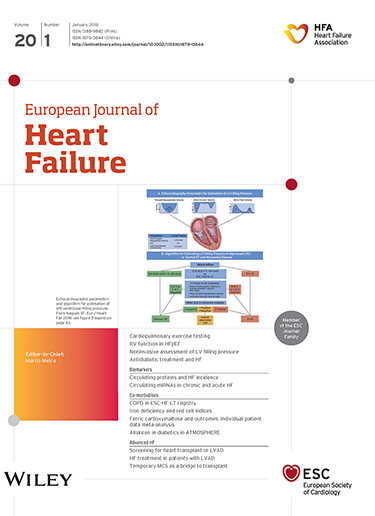Multimodality imaging in advanced heart failure. A clinical consensus statement of the Heart Failure Association of the ESC. Part 1: Multimodality imaging for the evaluation of patients with advanced heart failure.
IF 10.8
1区 医学
Q1 CARDIAC & CARDIOVASCULAR SYSTEMS
引用次数: 0
Abstract
Heart failure (HF) represents a significant global health burden, with approximately 10% of patients progressing to advanced stages characterized by severe symptoms and recurrent hospitalizations despite conventional treatments such as guideline-directed medical therapy, devices, and surgery. This clinical consensus statement from the Heart Failure Association of the European Society of Cardiology discusses the applications of imaging modalities in patients with advanced HF. Transthoracic echocardiography remains the cornerstone for initial diagnosis and monitoring, providing critical insights into cardiac volumes, function, and valvular integrity, as well as congestion status. Transoesophageal echocardiography offers detailed evaluations of valve pathology, essential for surgical or transcatheter planning. Cardiovascular magnetic resonance provides comprehensive assessments of biventricular size and function, tissue characterization, and flow dynamics, proving particularly useful for diagnosing specific HF aetiologies. Computed tomography offers valuable insights into pulmonary artery diameter, right ventricular volume, and valvular anatomy, which are crucial for guiding percutaneous procedures. Nuclear imaging techniques allow assessing viability and diagnosing non-ischaemic HF conditions, guiding revascularization decisions. Advanced imaging techniques have expanded the understanding and management of right ventricular dysfunction. The integration of these advanced imaging modalities enhances diagnostic accuracy, risk stratification, and therapeutic decision-making, ultimately improving the prognosis and quality of life for patients with advanced HF. This clinical consensus statement highlights the critical role of various imaging modalities in managing patients with advanced HF, excluding those needing mechanical circulatory support or heart transplantation, emphasizing the multifaceted approach required for effective management.晚期心力衰竭的多模态显像。ESC心力衰竭协会的临床共识声明。第1部分:多模态成像对晚期心力衰竭患者的评价。
心力衰竭(HF)是一项重大的全球健康负担,尽管采用了指南指导的药物治疗、器械和手术等常规治疗,但仍有大约10%的患者进展为晚期,其特征是严重症状和反复住院。这份来自欧洲心脏病学会心衰协会的临床共识声明讨论了成像方式在晚期心衰患者中的应用。经胸超声心动图仍然是初步诊断和监测的基础,提供了对心脏容量、功能、瓣膜完整性和充血状态的关键见解。经食管超声心动图提供瓣膜病理的详细评估,对手术或经导管计划至关重要。心血管磁共振提供了双心室大小和功能、组织特征和血流动力学的全面评估,证明对诊断特定的HF病因特别有用。计算机断层扫描对肺动脉直径、右心室容积和瓣膜解剖结构提供了有价值的见解,这对指导经皮手术至关重要。核成像技术可以评估生存能力和诊断非缺血性心衰情况,指导血运重建决策。先进的影像技术扩大了对右室功能障碍的认识和管理。这些先进成像方式的整合提高了诊断准确性、风险分层和治疗决策,最终改善了晚期心衰患者的预后和生活质量。这一临床共识声明强调了各种成像方式在治疗晚期心衰患者中的关键作用,不包括那些需要机械循环支持或心脏移植的患者,强调了有效治疗所需的多方面方法。
本文章由计算机程序翻译,如有差异,请以英文原文为准。
求助全文
约1分钟内获得全文
求助全文
来源期刊

European Journal of Heart Failure
医学-心血管系统
CiteScore
27.30
自引率
11.50%
发文量
365
审稿时长
1 months
期刊介绍:
European Journal of Heart Failure is an international journal dedicated to advancing knowledge in the field of heart failure management. The journal publishes reviews and editorials aimed at improving understanding, prevention, investigation, and treatment of heart failure. It covers various disciplines such as molecular and cellular biology, pathology, physiology, electrophysiology, pharmacology, clinical sciences, social sciences, and population sciences. The journal welcomes submissions of manuscripts on basic, clinical, and population sciences, as well as original contributions on nursing, care of the elderly, primary care, health economics, and other related specialist fields. It is published monthly and has a readership that includes cardiologists, emergency room physicians, intensivists, internists, general physicians, cardiac nurses, diabetologists, epidemiologists, basic scientists focusing on cardiovascular research, and those working in rehabilitation. The journal is abstracted and indexed in various databases such as Academic Search, Embase, MEDLINE/PubMed, and Science Citation Index.
 求助内容:
求助内容: 应助结果提醒方式:
应助结果提醒方式:


